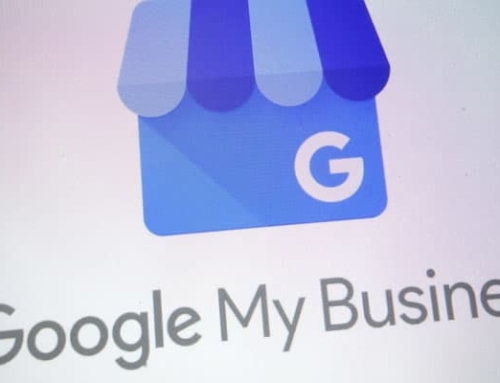Local SEO Guide For Plumbers to Improve Local Search Rankings
Are you looking to rank your plumbing business #1 for local searches?
You’re on the right page.
Getting your plumbing business to show up in local searches when customers need your services isn’t a walk in the park.
Besides, every local plumbing business owner is competing to appear at the top of Google searches.
This is because 46% of all Google searches come from users looking for businesses in their local area or within a specific city, county, state, etc.
Besides, 78% of mobile users searching for services within a given location end up purchasing on a story.
With such interesting stats, how do you get your plumbing services in front of customers when they need your services?
In this definitive guide to local SEO for plumbers, we will walk you through every step of optimizing your business for local searchers.
But before that let’s understand a few basic things.
What Is Local SEO For Plumbers?
Local SEO is all about optimizing your plumbing business or website to show up on Google especially on local 3-pack when users search using city or location-specific keywords.

Think of local SEO as the advanced version of “yellow pages.”
Local SEO helps your business to rank higher on search engines.
undefined
Google Maps vs. Google Results: What’s the Difference?
Google Maps is a web-based service from Google that shows a free online map with detailed information about local businesses and other physical locations such as hospitals, schools, and more.
Google Maps allows users to view maps, get driving directions, find local businesses, and more.
On the other hand, Google results, also known as organic search results are the classic listings displayed on a relevant search on Google.
They are displayed below ads and local search results and are ranked based on page relevance which is determined by Google’s search algorithm.
Why Should Plumbers Invest in Local SEO?
Why is local SEO important for plumbers?
When searching for plumbing services, most people will head over to Google and search for the term “Plumber + the city, region, or county they live in.”
Users looking for local plumbing services tend to skip the paid ads and click on the links that appear right below the ads.
SEO is a potential driver for organic traffic, which explains why companies are willing to invest between $300 and $2,000 per month on local SEO campaigns.
That said, here are some of the potential reasons why you should invest in local SEO for your plumbing business.
- Google handles over 6 billion searches per day, most of which are for consumers looking for information about local businesses.
- Local SEO is a great source for free traffic. When you optimize your website and Google My Business profile for your plumbing business, you get higher Google rankings which attract free visitors and increase conversions.
- Fast local search rankings. Since you’re competing against the plumbing companies within your geographic area, optimizing your online presence properly can help to get fast rankings.
With that, let’s take a look at how to rank your plumbing business #1 for local searches.
Optimize Your Website for Local Search
It all starts with your plumbing business website. To improve the visibility of your website on local searches, you need to optimize it for local SEO.
Here is a step by step process how to optimize your website for local search:
Step #1: Start With Keyword Research
Most consumers looking for plumbing services near them will most likely enter keywords like “plumber” followed by the city, region, or state they live in. For instance, let’s say they are looking for plumbing services in New Jersey, a user may enter the phrase “Plumber in New Jersey” or “Plumber + Neighboring City”
These are the keywords you should aim to rank for.
That’s where keyword research becomes helpful.
The good news is that there are many free keyword research tools out there that can help you discover the exact keywords customers are entering into their browsers when looking for plumbing services.
Examples of powerful free keyword research tools include Google Keyword Planner, SEMrush, Ubersuggest, Google Search Console, Google Trends, and more.
Once you pick a tool, enter the keyword “Plumber in (your city, state, county, etc.)”. This will be the starting point for your keyword research.
In our case, we’re going to use Ubersuggest. It’s one of the best free keyword research tools that will give you new and fresh keyword ideas for local search optimization.
Ubersuggest keyword research tool
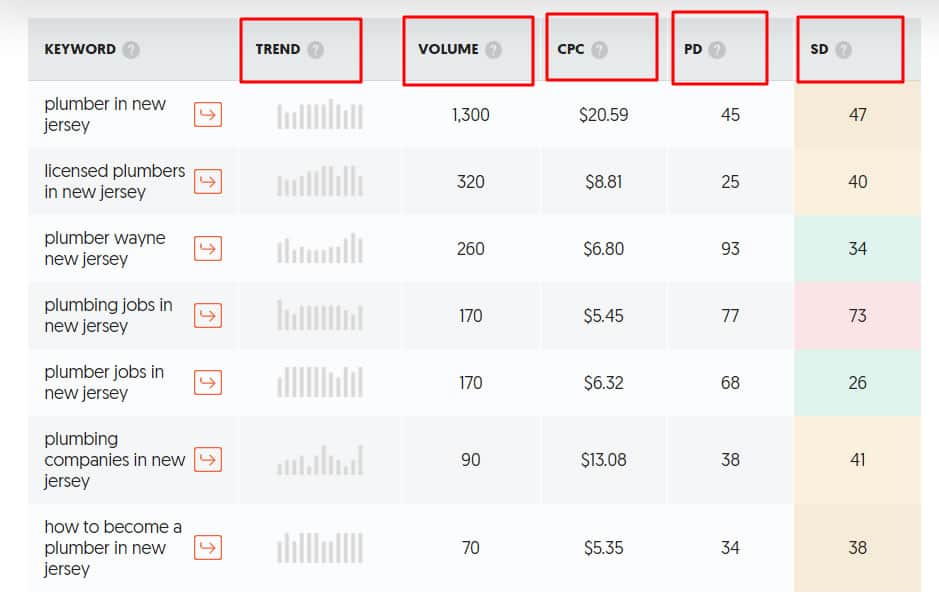
As you can see, the tool gives you for following information related to your keyword:
- Trend: Shows the search volume of the keyword over the 12 months;
- Volume: Shows the number of searches your keyword has received during a month;
- CPC: (Cost Per Click) The amount of money users are spending on Google ads to have their keywords ranked higher. The higher the CPC the more valuable the keyword is.
- PD: (Paid Difficulty) Estimated competition in paid search. The higher the PD umber the more competitive the keyword is;
- SEO Difficulty: Estimated competition in organic search. The higher the SD number, the more competitive the keyword is in organic search.
Going by our example, the keyword “plumber in New Jersey” is worth ranking for since there are over 1,000 people already searching for it.
You can consider expanding your area to a bigger city or state or county if the search volume is too low.
Remember that your plumbing keyword is just a starting point or focus keyword and not the only keyword to rank for.
After determining your focus keyword, you can expand your search for more specific and relevant keywords. LSI graph is one of the best free keyword research tools to help you discover phrases related to your main keyword.
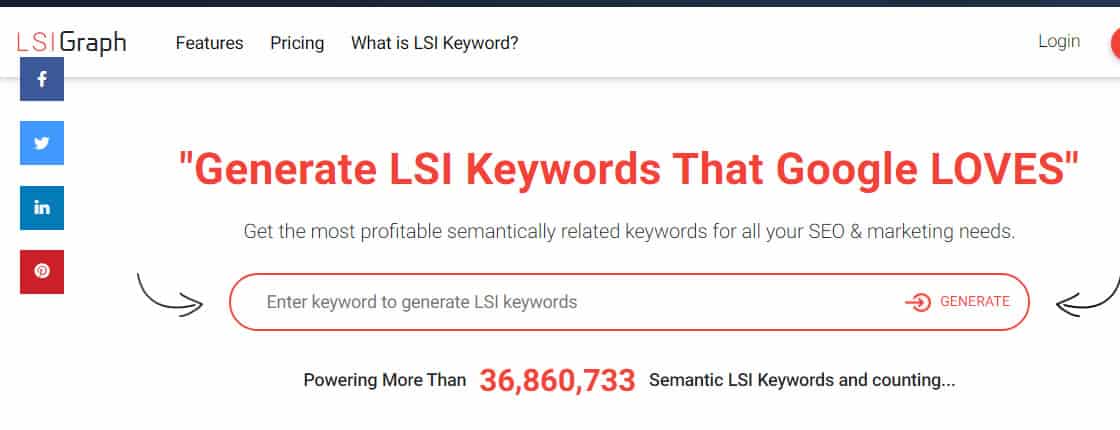
On-Page SEO
Once you have discovered potential keywords to rank for your plumbing website, you need to add them to your blog pages, homepage, service pages, and more.
Here are the steps to optimize your website for on-page SEO.
Optimize your URL structure
The first thing you need to optimize is your website’s URL structure. As a rule, the URL should be short and keyword-rich.
By default, search engines assign a URL to your pages with something like https://www.yourdomain.com/lp/sem/en&cmp.
In this case, you should optimize the URL to include the primary keyword your looking to rank for.
For example, if you offer drain repair and clog removal services, your page should have a URL with https://www.yourdomain.com/drain-repair-clog-removal.
Notice how we use dashes instead of underscores in the URL. Ensure all URLs on your website are optimized for the keywords you want to rank for. Avoid targeting the same keywords on multiple pages.
Optimize the meta description
Each webpage must have a catchy meta description that briefly summarizes the content of the webpage. Google allows a meta description length of between 150 and 220 characters for both desktop and mobile users.

You should include the primary keyword in the meta description of each page plus a call-to-action at the end of the description if possible.
Optimize the body copy on each page
Each webpage should have a copy that covers the topic you’re conveying thoroughly. For instance, the homepage should provide some background information about your plumbing business such as the plumbing services offered, service area, business location, and more.
Remember to add a call-to-action at the end to encourage visitors to take action after learning more about your business.
Include the primary keyword in the first paragraph of the body copy and related keywords once or twice within the copy.
Add your contact information (NAP) at the footer of your website. Provide your business name, postal office address, phone number, and other contact details.
Since the footer remains constant no matter the page your visitor is viewing, having your contact information listed in this section makes it easy for them to contact you right away if they are interested in your services.
Google loves fresh content. Sharing unique, high-value content optimized for local SEO can help to increase rankings of your web pages. Include high-quality images as well to make your content engaging and visually impressive.
Enable click-to-call plumber option
Once customers find your website and learn more about your services, don’t give them a hard time when they want to contact you. Add a phone number so they can click and call you directly via their phones. This helps to improve customer experience.
Add happy customer testimonials
Customer reviews are among the top local search ranking signals according to Google.
Display reviews from your previous happy customers to allow new and prospective customers to gain trust in your services. Remember that reviews are like word-of-mouth marketing.
Add as many happy customer testimonials as possible across all your platforms include Google My Business, social media, website, and more, and ensure you respond to all of them.
Technical On-Site SEO
Fix all technical SEO issues that could make users have a bad experience when interacting with your website. Remember that when users are frustrated when using your website, Google knows that. This can hurt your local SEO rankings.
Here are a few ways to fix all technical issues:
Optimize your website for mobile users
Mobile accounts for approximately 54.8 %(over half of the web traffic worldwide.

Besides, 76% of mobile local searchers visit a physical location within 24 hours and 28% of them end up making a purchase.
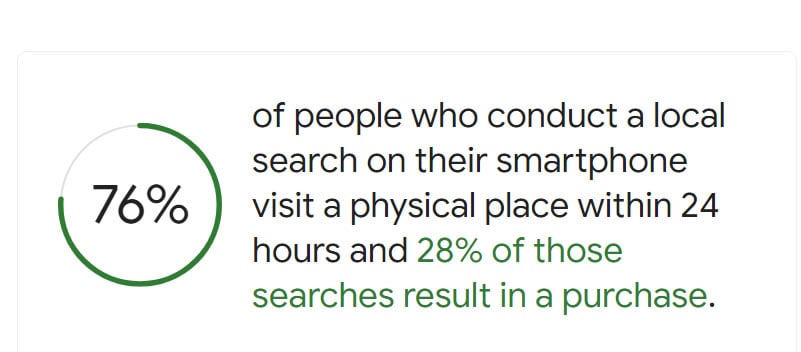
Google now uses mobile-first indexing when indexing and ranking content. That means that Google favors mobile content over desktop.
Optimize your website for mobile users using Google’s Mobile-Friendly Test to improve your rankings on mobile and desktop.
Improve page load speed
Google favors web pages that load fast. Ideally, your web pages should take less than 3 seconds.
Many factors can affect your page load speed. Uploading large images, non-optimized CSS, sluggish hosting is just a few factors that affect how quickly a page loads.
Use Google’s PageSpeed Insights and Mobile Speed Test to test your website and optimize the speed accordingly.
Read this article and this to learn more about technical SEO issues and how to fix them.
Off-Page SEO
Once you have fixed all technical SEO issues, sort out your off-page SEO.
Follow the steps below:
Optimize Google My Business for your plumbing business
If you haven’t listed your plumbing business on Google My Business listings then you’re missing out on a lot of amazing business opportunities. 64% of customers use Google My Business to find contact information. That means that they are interested to do business with you hence they want to take the next step by contacting you.
Remember that Google My Business appears right below Google’s paid advertisements. This means that optimizing your plumbing business Google My Business profile can help to position you on the first page of SERPs.
Now the first thing to do is to claim and optimize your Google My Business as a plumber.
Follow the simple steps below to claim and optimize your Google My Business profile:
- Create your Google My Business profile: Click this link https://www.google.com/business/ to get started and fill out each section with accurate information about your plumbing business.
- Set your geographical radius: Let customers know the areas you serve.
- Set primary and secondary categories: Categories are items that identify and tell more about what your business does. In this case, you’re a plumber so plumbing might be your primary category followed by other services you offer.
- Provide a brief description of your business: In about 750 characters, summarize what your business does. Add relevant keywords here to make your description searchable. You can list the services you offer in bullet points.
- Add beautiful photos: Upload high-definition images, videos, and photos of your employees or customers using your services. This will help to beautify your Google My Business listing. Remember to use geotags and keywords in the image alt text and captions.
- Verify your Google My Business profile. You can verify your Google My Business listing in two different ways: via phone or email. Once you verify your business listing, no one can claim it as their own. Google My Business page verification can take a couple of days to complete so be patient and follow all Google’s guidelines.
- Get custom reviews, ask and answer questions: Ask customers to leave reviews on your listing to send signals to Google that you’re a trusted local plumber. Populate the ask and question sections with questions and answers related to your business to help customers understand your services and how you can help them.
- Create Google posts: Google allows you to create posts to be featured in your Knowledge Panel. You have up to 1,500 characters to educate your customers more about your services, share upcoming events, and more. Keep this section updated with fresh content regularly.
There are tons of local plumber-related citations out there to have your business name and contact information listed.
Once you have set up and optimized your website and listed your business on Google My Business, the next step is to get listed on plumbing directories. Get listed on free industry-specific directories both locally and internationally first. Make sure your website and Google My Business profile information is consistent.
Examples of popular plumber related directories to get listed include:
- Homeblue.com;
- Plumbingweb.com;
- Masterplumbers.com;
- Findaplumber.com;
- Fixr.com;
- Plumbingnet.com;
- Bestplumbers.com
- Greenplumbersusa.com;
- Yelp.com.
- And more
More than half of the world’s population (57.6%) uses social media today.
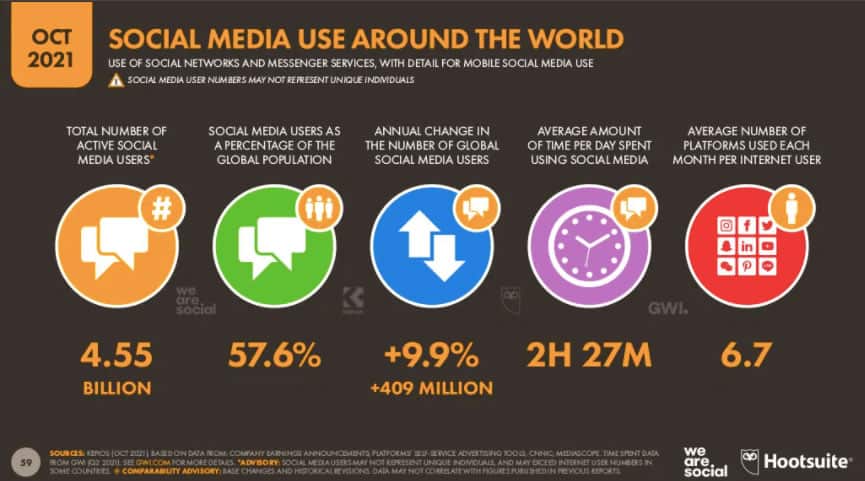
It’s no doubt that your customers are on social media. To stay social, create a profile on social media platforms where your customers spend most of their time and promote your plumbing services there. This could be on Facebook, Instagram, Twitter, and more.
Track your local SEO results
The last but not least item in our local SEO guide for plumbers is tracking results.
Once you have successfully launched your local SEO campaign for your plumbing business, you need to track three items; Rankings, Traffic, and Conversions. This will help you determine how your local SEO keywords are performing.
There are lots of free and paid SEO tools to help you track your SEO campaign results. Ubersuggest, Ahrefs, Google Analytics, RankRanger are just a few of the most powerful tools you can use to track your SEO campaign results.
Not Sure Where to Begin?
We’ve got your back.
Investing in a solid local SEO campaign for your plumbing business is the best decision you can make.
Cube Digi Media is a team of professionals who offer a wide range of services to our esteemed clients including On-Page SEO, Keyword Research, Social Media Optimization, Google My Business Optimization, and more. Our primary focus is to identify your key problem areas and provide customized solutions accordingly.
Book a free local SEO consultation today!




